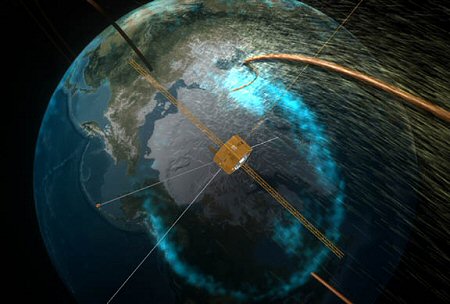|
Immense cracks in our planet's magnetic
field can remain open for hours, allowing the solar wind to gush
through and power stormy space weather.
by Ron Koczor
Earth is surrounded
by a magnetic force field - a bubble in space called "the magnetosphere"
tens of thousands of miles wide. Although many people don't know
it exists, the magnetosphere is familiar. It's a far flung part
of the same planetary magnetic field that deflects compass needles
here on Earth's surface. And it's important. The magnetosphere acts
as a shield that protects us from solar storms.
According to new observations,
however, from NASA's IMAGE spacecraft and the joint NASA/European
Space Agency Cluster satellites, immense cracks sometimes develop
in Earth's magnetosphere and remain open for hours. This allows
the solar wind to gush through and power stormy space weather.
"We've discovered that
our magnetic shield is drafty, like a house with a window stuck
open during a storm," says Harald Frey of the University of California,
Berkeley, lead author of a paper on this research published Dec.
4 in Nature. "The house deflects most of the storm, but the couch
is ruined. Similarly, our magnetic shield takes the brunt of space
storms, but some energy slips through its cracks, sometimes enough
to cause problems with satellites, radio communication, and power
systems."
"The new knowledge
that the cracks are open for long periods can be incorporated into
our space weather forecasting computer models to more accurately
predict how our space weather is influenced by violent events on
the Sun," adds Tai Phan, also of UC Berkeley, co-author of the Nature
paper.
The solar wind is a
fast-moving stream of electrically charged particles (electrons
and ions) blown constantly from the Sun. The wind can get gusty
during violent solar events, like coronal mass ejections (CMEs),
which can shoot a billion tons of electrified gas into space at
millions of miles per hour.

An artist's
rendition of NASA's IMAGE satellite flying through a 'crack'
in Earth's magnetic field.
|
Earth's magnetosphere
generally does a good job of deflecting the particles and snarled
magnetic fields carried by CMEs. Even so, space storms and their
vivid effects, like auroras which light up the sky over the polar
regions with more than a hundred million watts of power, have long
indicated that the shield was not impenetrable.

An artist's
rendition of magnetic reconnection. The amber-brown lines
denote lines of magnetic force. The bright spot is where
oppositely-directed fields are making contact and "reconnecting."
|
In 1961, Jim Dungey
of the Imperial College, United Kingdom, predicted that cracks might
form in the magnetic shield when the solar wind contained a magnetic
field that was oriented in the opposite direction to a portion of
the Earth's field. In these regions, the two magnetic fields would
interconnect through a process known as "magnetic reconnection,"
forming a crack in the shield through which the electrically charged
particles of the solar wind could flow.
In 1979, Goetz Paschmann
of the Max Planck Institute for Extraterrestrial Physics in Germany
detected the cracks using the International Sun Earth Explorer (ISEE)
spacecraft. However, since this spacecraft only briefly passed through
the cracks during its orbit, it was unknown if the cracks were temporary
features or if they were stable for long periods.
In the new observations,
the Imager for Magnetopause to Aurora Global Exploration (IMAGE)
satellite revealed an area almost the size of California in the
arctic upper atmosphere where a 75-megawatt "proton aurora" flared
for hours. A proton aurora is a form of Northern Lights caused by
heavy solar ions striking Earth's upper atmosphere, causing it to
emit ultraviolet light - invisible to the human eye but detectable
by the Far Ultraviolet Imager on IMAGE. While this aurora was being
recorded by IMAGE, the 4-satellite Cluster constellation flew far
above IMAGE, directly through the crack, and detected solar wind
ions streaming through it.
This stream of solar
wind ions bombarded our atmosphere in precisely the same region
where IMAGE saw the proton aurora. The fact that IMAGE was able
to view the proton aurora for more than 9 hours implies that the
crack remained continuously open. Researchers estimate that the
crack was twice the size of Earth at the boundary of our magnetic
shield - about 38,000 miles (60,000 km) above the planet's surface.
Since the magnetic field converges as it enters the Earth in the
polar regions, the crack narrowed to about the size of California
down near the upper atmosphere.
Fortunately, these
cracks don't expose Earth's surface to the solar wind. Our atmosphere
protects us, even when our magnetic field doesn't. The effects of
solar storms are felt mainly in the high upper atmosphere and the
region of space around Earth where satellites orbit.
|
